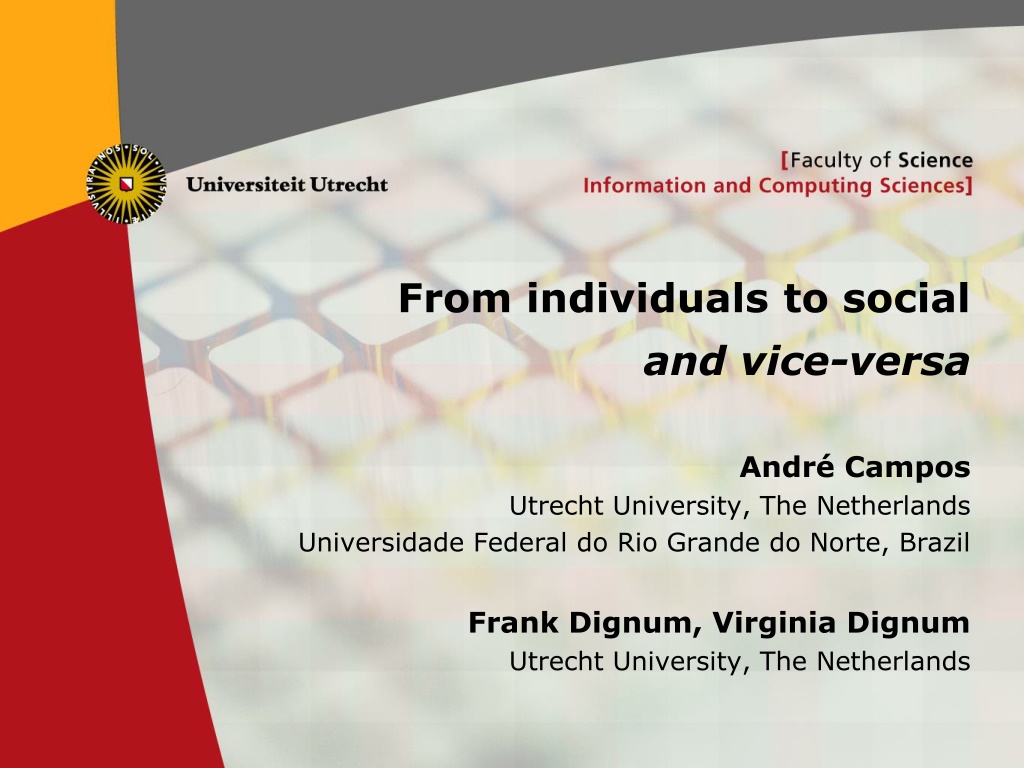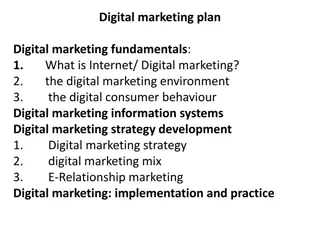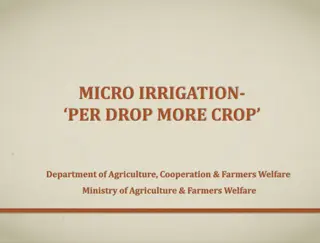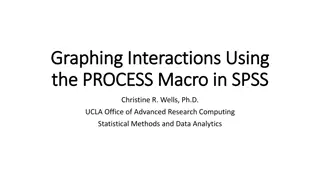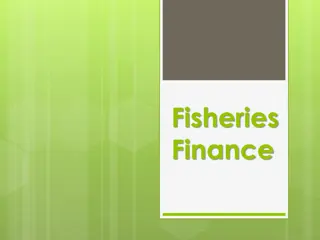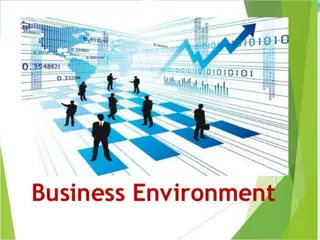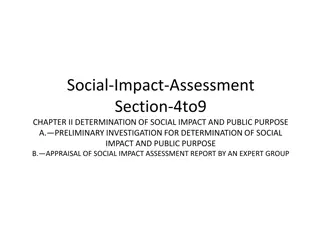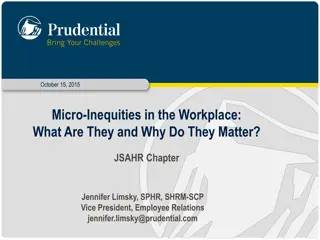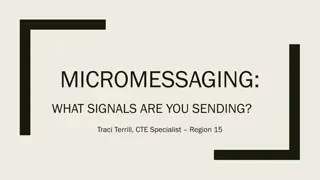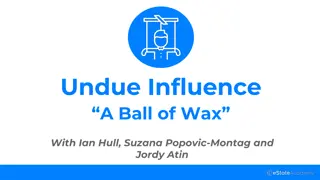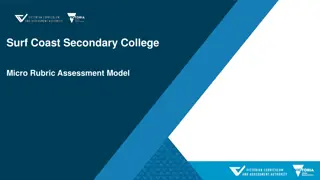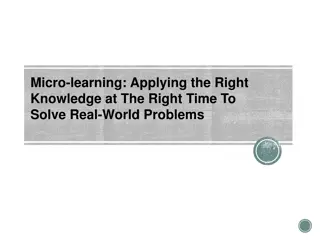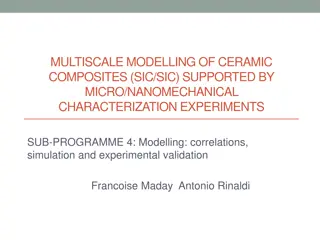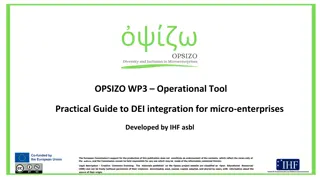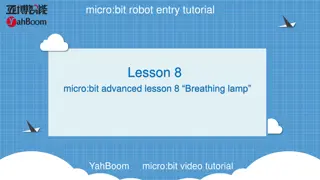Understanding Social Influence in Micro and Macro Levels
This study explores the dynamics of social influence at both individual (micro) and collective (macro) levels, highlighting the interconnected nature of behaviors. It discusses the motivation behind different simulation approaches, outlines objectives to study cyclical behaviors, and examines processes of social influences based on compliance, identification, and internalization. The role of social elements in negotiating environmental tasks is also analyzed.
Uploaded on Sep 26, 2024 | 0 Views
Download Presentation

Please find below an Image/Link to download the presentation.
The content on the website is provided AS IS for your information and personal use only. It may not be sold, licensed, or shared on other websites without obtaining consent from the author. Download presentation by click this link. If you encounter any issues during the download, it is possible that the publisher has removed the file from their server.
E N D
Presentation Transcript
From individuals to social and vice-versa Andr Campos Utrecht University, The Netherlands Universidade Federal do Rio Grande do Norte, Brazil Frank Dignum, Virginia Dignum Utrecht University, The Netherlands 1
Motivation Different approaches in social simulation Micro-models aim to see emergent properties in the macro levels Macro-models do not take individuals into account Micro-macro models usually aim to: Validate macro behaviors through adequade micro-models Limit emergence through constraints in the macro-model Micro and macro behavior are deeply related Micro influences macro, which influences micro, which influences macro, which influences... 2
Objectives To design a framework where the cyclical behavior (micro- macro) can be studied Sub-goals To define a generic agent architecture able to represent the impact of social influences on individuals To define (or reuse) a generic social framework able to be adapted according to the individuals To define a way in which both levels of abstraction influence each other 3
Processes of social influences Based on the work of H.Kelman (social psychologist) Social influence can be expressed through 3 processes: Compliance: occurs when an individual wants to attain a favorable reaction from the other Identification: occurs when an individual wants to establish or maintain a satisfying relationship to the other Internalization: occurs in order to maintain the equivalent correspondence of actions and beliefs with his or her own value system 4
Social influence in social elements Tasks that all social elements* perform as they negotiate their social environment Protect and promote their interests: it is related to the Compliance process (rewards or punishments) Establish and maintaint their relationships: it is related to the Identification process (roles and depedencies and what is expected from them) Affirm and express their identities: it is related to the Internalization process (sharing of values) * individuals, groups, organizations, societies, 5
Meso layer and the social influence The meso layer is a way to facilitate the model translation between micro and macro Includes Norms Social structures Cultural backgrounds It can be seen as an organizational approach of the society (Goals, roles etc.) We ve applied of social influence studies in the micro-meso interface macro - + meso micro Adapted from (Dignum et al. 2008) 6
Rules, roles, and values To protect interests, it is necessary Rules To maintaint relationship, it is necessary Roles To express identities, it is necessary Values Individual and social systems are integrated by: The adherence of their rules The involvement in their roles The sharing of their values Examples of conflicts of rules, roles, and values A couple in a working environment where it is forbidden couples working together A man who wants to contribute to his country but was invited to figth in a war that he is against 7
Social enactments The conflicts (or the absence of them) help to model different attitudes regarding role enactments Social enactment: the individual gives priority to its role s goals Selfish enactment: the individual gives priority to its own goals Maximally social enactment: the individual ignores its own goals for the duration of the role enactment Maximally selfish enactment: the individual ignores the role s goals 8
Meso and micro social influence From meso to micro From micro to meso Individual Individual Group Group Rules Rules Roles Roles Values Values Values Values Group says: These are my rules that you must follow when playing these roles to me in order to bring or maximize some shared values . Individual says: These are my rules that I will follow as a member of group playing these roles to me in order to bring or maximize some shared values . 9
The meso layer Based on a subset of the OperA framework Organizational model Social structure Normative structure Social model Social contract It can be extended to introduce links between Norms and goals (a norm exists for a reason) Goals and values (a goal exists for maximizing a value) 10
The micro layer It is necessary to represent the impact of the social on the individuals and what impacts on the social level Human behavior as a conjunction of Reasoning (decision-making) Emotions Personality Personal values (cultural background, ethical or moral beliefs etc.) 11
Elements of an agent architecture Reasoning BDI-like decision-making process It can easily express the elements of social influence (e.g. interests are goals in the BDI approach) Emotions OCC model (Ortony-Clore-Collins model) It is an exclusively cognitive approach (emotions as a reaction from a perceived situations) Personality MBTI (Myers-Briggs Type Indicator) It can be easily adapted to model processes rather than contents 12
The agent architecture Perception Action Decision making component Emotional component Inference Deliberation Self-evaluation plan Beliefs Emotions possible worlds Personality Social component Compliance Identification Internalization Rules Roles Values 13
General overview Emotions and goals drive the possible worlds reasoning Emotions are a result from the Perceived social environment Possible worlds foreseen Social component is responsible for identifying conflicts with personal and social rules, roles, and values Personality model how the processes are performed Sensing vs. Intuition Thinking vs. Feeling 14
The cognitive process (1) How the agent perceive the world? Perception Action Decision making component Emotional component Inference Deliberation Self-evaluation plan Beliefs Emotions possible worlds Personality Social component Compliance Identification Internalization Rules Roles Values 15
The cognitive process (2) How this perceived world impact on the agent vision? Perception Action Decision making component Emotional component Inference Deliberation Self-evaluation plan Beliefs Emotions possible worlds Personality Social component Compliance Identification Internalization Rules Roles Values 16
The cognitive process (4) Which emotions may be raised from this impact? Perception Action Decision making component Emotional component Inference Deliberation Self-evaluation plan Beliefs Emotions possible worlds Personality Social component Compliance Identification Internalization Rules Roles Values 17
The cognitive process (5) What can happens? Perception Action Decision making component Emotional component Inference Deliberation Self-evaluation plan Beliefs Emotions possible worlds Personality Social component Compliance Identification Internalization Rules Roles Values 18
The cognitive process (6) What the agent can do? Perception Action Decision making component Emotional component Inference Deliberation Self-evaluation plan Beliefs Emotions possible worlds Personality Social component Compliance Identification Internalization Rules Roles Values 19
Limited possible worlds reasoning Node expansion t0 t1 W10 W00 W10 W11 W12 W01 W02 W11 W12 W11.1 W11.2 W01.1 W01.2 W11.1 W11.2 W12.1 W12.2 W12.1.1 W12.1.2 ti - Virtual time iteration - Current perceived world (on iteration i) Wi0 - Possible worlds nodes in a hierarchical branch structure Wia,b.. - World state that accomplishes the agent goals Wia,b.. Wia,b.. - World state where the agent emotional focus is 20
A general algorithm while alive S = get stimuli (outer world) B = update beliefs (S, T) I = evaluate impact (B, Ru, Ro, Va) E = update emotions (B, I, T) repeat W = review possible worlds (B, P, E, I, T, A) E = update emotions (B, I, T) until not(panic(E)) or has to react (B, T) if empty(P) v achievable(P,W) v reconsider(P,B) D = gather desires (Ru, Ro, Va, E, P, T) I = define intention (B, D, I, T) P = generate plan (W, I, A, T) execute action (P, A) 21
Final remarks Work in progress (high level of abstraction) Example of possible applications Study of social/group policies on the individuals Study of group dynamics (e.g. group formation) Study of insurgent movements Next steps Formalization and implementation (2APL) Development of a simulation scenario Integration with other IS works Complex scenarios using personality-based negotiations Importing OperA models to compose the meso-layer 2APL plugins for planning over the possible worlds ... Suggestions? 22
